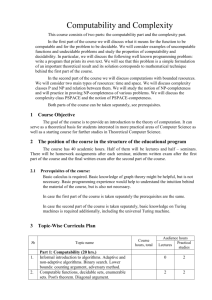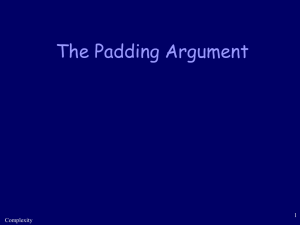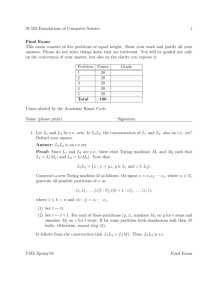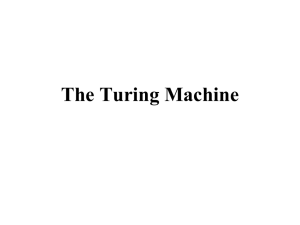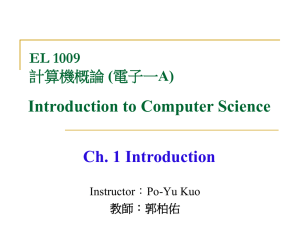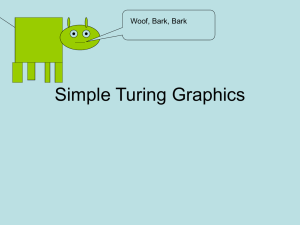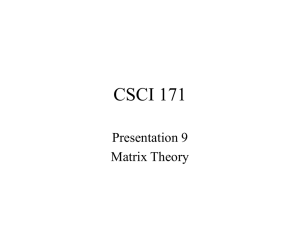Space Complexity
advertisement
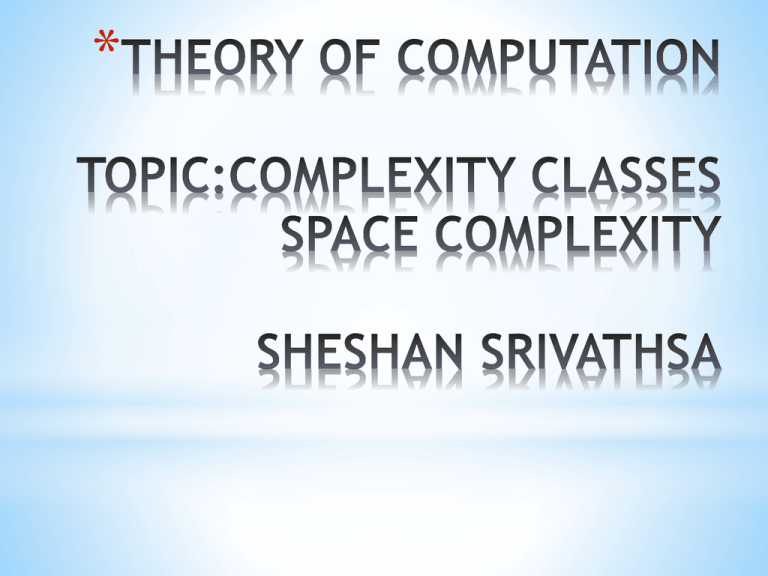
*
*
Definition:
Let M be a deterministic Turing Machine that halts on all inputs.
Space Complexity of M is the function f:NN, where f(n) is the
maximum number of tape cells that M scans on any input of length n.
For any function f:NN, we define:
SPACE(f(n))={L | L is a language decided by an O(f(n)) space DTM}
NSPACE(f(n))={L | L is a language decided by an O(f(n)) space NTM}
*
Low Space Classes:
Definitions (logarithmic space
classes):
L = SPACE(logn)
NL = NSPACE(logn)
*
If M is a deterministic Turing machine that halts on an inputs, then the value of
spacereq(M) is the function f(n) defined so that, for any natural number n,f(n) is
the maximum number of tape squares that M reads on any input of length n.
If M is a nondeterministic Turing machine all of whose computational paths halt on all
inputs, then the value of spacereq(M) is the function f(n) defined so that, for any natural
number n,f(n) is the maximum number of tape squares that M reads on
any path that it executes on any input of length n.
*
SAT is NP-complete.
SAT can be solved in linear(O(m)) space.
M1=“On input <>, where is a Boolean formula:
1.
For each truth assignment to the variables x1,…xm of .
2.
Evaluate on that truth assignment.
3.
If ever evaluate to 1, ACCEPT; if not, REJECT.”
x1 x2 x3
0
0
0
…
…
xn
0
*
Theorem: Given a Turing machine M = (K , 2:., r, 8, s, H) and assuming that spacereq(M) ~ n,
the following relationships hold between M's time and space requirements:
spacereq(M) < timereq(M) E o (cspacereq(M) )
Proof: Spacereq(M) is bounded by timereq(M) since M must use at least one time step for every
tape square it visits.
The upper bound on timereq(M) follows from the fact, since M halts, the number of steps that it
can execute is bounded by the number of distinct configurations that it can enter. That number is
given by the function MaxConfigs(M), as described above. Since MaxConjigs(M) E
O(cspacereq(M»), timereq(M) E O(cspacereq(M»).
*
Theorem
For any function f: NR+, where f(n)n, we have
NSPACE(f(n)) SPACE(f2(n)).
Proof:
Suppose language A can be decided by an NTM in k f(n) space,
for some constant k.
We shall show that it can be decided by a DTM in O((f(n))2) space.
Let be an input string to N.
t: integer;
c1,c2: configurations of N on .
*
CANYIELD(c1,c2,t) accept if starting from c1 N has a branch
entering configuration c2 in t steps; o/w rejects.
CANYIELD=“On input c1,c2 and t:
1.
2.
3.
4.
5.
If t=1, test whether c1=c2 or c1├ c2, then accept; else reject.
If t>1, then for each configuration cm of N on using
space f(n).
Run CANYIELD(c1,cm, )
Run CANYIELD(cm,c2, )
If 3 & 4 both accept, then accept; else reject.”
caccept: accept configuration.
cstart: start configuration of N on .
Select a constant d so that N has no more than 2df(n) configurations
using f(n) tape space, n=| |.
M=“On input
output the result of CANYIELD(cstart, caccept, 2df(n)).”
CANYIELD is a recursive procedure:
•Recursive depth:log22df(n)=O(f(n))
•Each recursive call of CANYIELD use O(f(n)) space.
•Thus, it uses O(f2(n)) space.
*
boolean PATH(a,b,d) {
if there is an edge from a to b then
return TRUE
else {
if (d=1) return FALSE
for every vertex v (not a,b) {
if PATH(a,v, d/2) and
PATH(v,b, d/2) then
return TRUE
}
return FALSE
}
}
2
3
1
4
*
PSPACE is the class of languages (or problems) that are decidable in
polynomial space on a det. TM.
Similarly we can define NPSPACE to be the class of languages that
are decidable in polynomial space by a NTM.
So, what is the relationship between PSPACE and
NPSPACE?
PSPACE = NPSPACE
Theorem:
PSPACE = NPSPACE
Proof : If L is in PSPACE, then it must also be in NPSPACE because
the deterministic Turing machine that decides it in polynomial time is
also a nondeterministic Turing machine that decides it in polynomial
time.
It is an important corollary of Savitch's Theorem.
*
Definition:
A language B is PSPACE-Complete if
1.
BPSPACE
2.
For every ASPACE, APB.
If B is just satisfies Condition 2, we say B is PSPACE-hard
*
Theorem: P ⊆ PSPACE
Proof: If a language is decided by some DTM M
in f(n) time, M cannot see more than f(n) cells.
Thus, TIME(f(n)) ⊆ SPACE(f(n)),
So that P ⊆ PSPACE
*
Proof: If a language is decided by some DTM M in f(n)
space (where f(n) >=n), M can visit at most f(n) 2 O(f(n))
configurations (why?) Thus, M must run in f(n) 2 O(f(n))
time.
In other words, SPACE(f(n)) ⊆ TIME(2O(f(n))),
so that PSPACE ⊆ EXPTIME.
P⊆NP⊆P SPACE⊆EXPTIME
*
*
Mathematical statements usually involve quantifiers: 8 (for all) and 9
(there exists)
• E.g., 8x F(x) means for every value of x, the statement F(x) is TRUE
• E.g., 9x F(x) means there exists some value of x such that F(x) is
TRUE
•Boolean formulas with quantifiers are called quantified Boolean
formulas
• E.g., 9y ( y = x+1) and 8x (9y ( y
formulas
x)) are quantified Boolean
All of the following are quantified Boolean expressions.
• (P 1\ ,R)~S
• 3P «P 1\ ,R) ~ S)
• \iR (3P «P 1\ ,R) ~ S»
• \iS (\iR (3P «P 1\ ,R) ~ S»).
All quantified Boolean expressions are in prenex
normal form.
*
Theorem: TQBF is PSPACE-Complete
Proof:
(s,t,|V|) is TRUE iff there is a path from s to t.
is constructible in poly-time.
Thus, any PSPACE language is poly-time reducible to TQBF,
i.e. TQBF is PSPACE-hard.
Since TQBFPSPACE, it’s PSPACE-Complete.
*
PSPACE-complete:
The generalized version of some common games we play
are PSPACE-complete:
Game of the Amazons
Tic-Tac-Toe
*
Generalized Geography : Each city chosen must begin
with the same letter that ended the previous city name.
*
L=SPACE(log n)
NL=NSPACE(log n)
E.G : PATH={<G,s,t> | G is a directed graph that has a directed path
from s to t}.
NL Completeness :
A language B is NL-Complete if
1. BNL
2. For every ANL, ALB.
*
Deterministic Space-Complexity Classes are Closed Under Complement
Theorem: For every function f(n) , dspace(f( n)) = co-dspace(f(n)).
Proof: If L is a language that is decided by some deterministic Turing machine M,
th en the deterministic Turing machine M' that is identical to M except that the
halting states y and n are reversed decides ~L. spacereq(M' ) = spacereq(M) .
So, if L E dspace(f( n)), so is ~L.
*
•
•
•
www.cs.tau.ac.il/~safra/Complexity/Space.ppt space complexity
•
2008 Elaine A Rich, Automata, Computability And Complexity,
Theory And Application (CHAPTER 29).
•
•
•
http://www.cs.elte.hu/~lovasz/kurzusok/complexity.pdf.
people.cs.nctu.edu.tw/~sctsai/fc/notes/SpaceComplexity.ppt
http://homepage.cs.uri.edu/faculty/hamel/courses/2013/spring201
3/csc544/lecture-notes/18-space-complexity.pdf
http://en.wikipedia.org/wiki/True_quantified_Boolean_formula
http://www.cs.nthu.edu.tw/~wkhon/lectures/.
